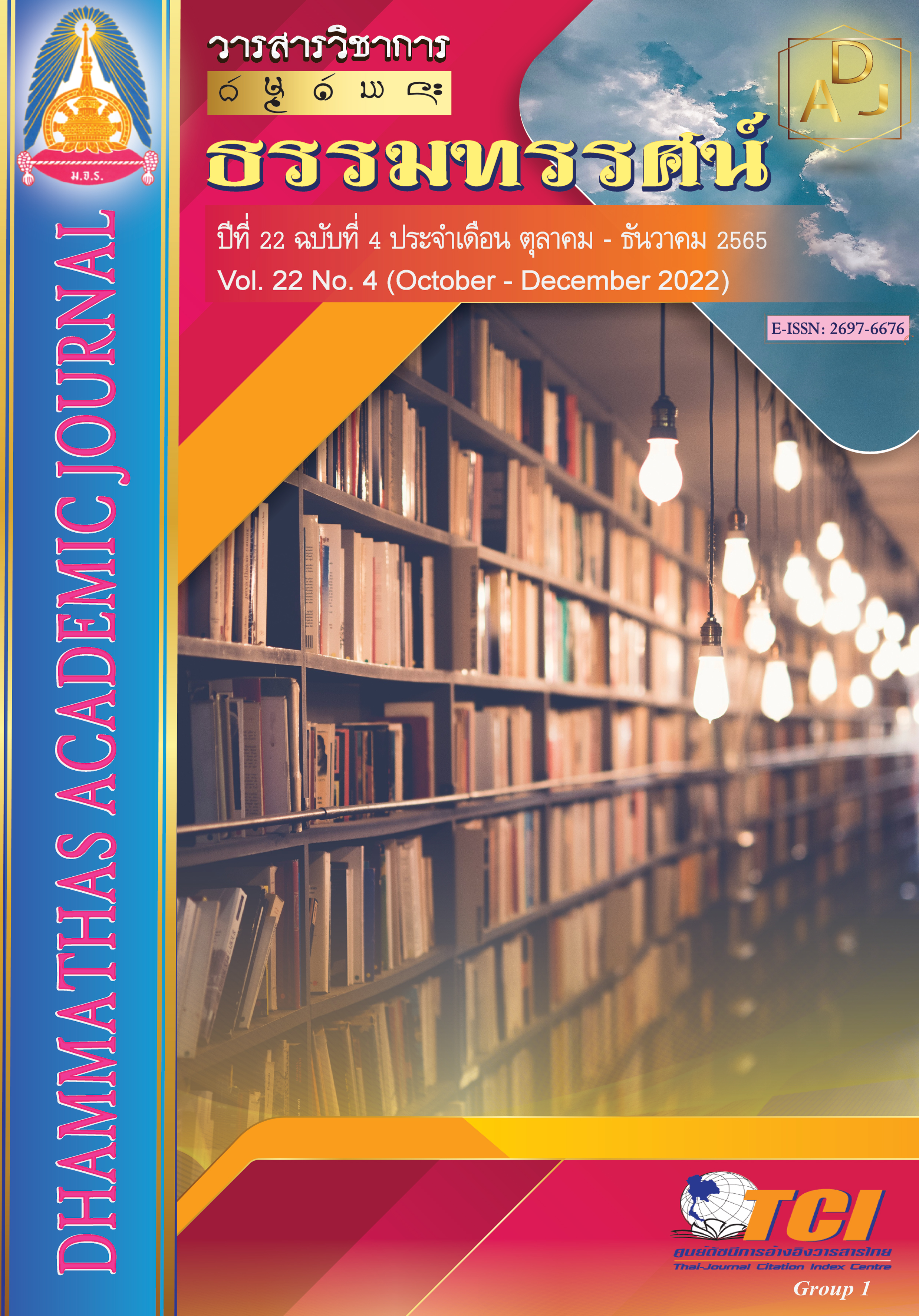A Factor Analysis of Drug Cased Prisoners’ Buddhist Intellectual Well-Being
Main Article Content
Abstract
The purposes of this research were 1) to study the dimension of the drug cased prisoners’ Buddhist intellectual well-being and 2) to investigate the congruence between the structured model of the drug cased prisoners’ Buddhist intellectual well-being and the empirical data. This study of factor Analysis of prisoners’ Buddhist intellectual well-being was quantitative research. The group of samples was 200 drug cased prisoners as dealer, addict and both who were sentenced to prison between one year up to ten years within the jail of Nakon Sawan Province in 2020, selected by criterion purposive sampling. The tool was the prisoner Buddhist intellectual well-being scale, total of 33 items. The reliability was at 0.76 and the statistic usedin data analysis was the Confirmatory Factor Analysis (CFA).
The research findings were as follows:
1. Confirmatory Factor Analysis of prisoners’ Buddhist intellectual well-being consisting of three factors were (1) knowing (2) awakening, and (3) delighting.
2. The model of the drug cased prisoners’ Buddhist intellectual well-being structure was fit to the empirical data with Chi-square (X2) = 2.29 (p-value = 0.51), GFI = 0.99, AGFI = 0.98, RMSEA = 0.00, SRMR = 0.04, standardized factor loading between 0.56-0.71, and all elements were statistically significant at 0.05 level.
Article Details

This work is licensed under a Creative Commons Attribution-NonCommercial-NoDerivatives 4.0 International License.
เพื่อให้เป็นไปตามกฎหมายลิขสิทธิ์ ผู้นิพนธ์ทุกท่านต้องลงลายมือชื่อในแบบฟอร์มใบมอบลิขสิทธิ์บทความ ให้แก่วารสารฯ พร้อมกับบทความต้นฉบับที่ได้แก้ไขครั้งสุดท้าย นอกจากนี้ ผู้นิพนธ์ทุกท่านต้องยืนยันว่าบทความ ต้นฉบับที่ส่งมาตีพิมพ์นั้น ได้ส่งมาตีพิมพ์เฉพาะในวารสาร วิชาการธรรม ทรรศน์ เพียงแห่งเดียวเท่านั้น หากมีการใช้ ภาพหรือตารางของผู้นิพนธ์อื่นที่ปรากฏในสิ่งตีพิมพ์อื่นมาแล้ว ผู้นิพนธ์ต้องขออนุญาตเจ้าของลิขสิทธิ์ก่อน พร้อมทั้ง แสดงหนังสือที่ได้รับการยินยอมต่อบรรณาธิการ ก่อนที่บทความจะได้รับการตีพิมพ์References
กรมราชทัณฑ์. (2563). หลังกำแพง: ส่องสภาพเรือนจำไทยภายหลังรัฐประหาร. กรุงเทพฯ: กรมราชทัณฑ์.
โกมาตร จึงเสถียรทรัพย์ และนภนาท อนุพงศ์พัฒน์. (2560). สุขภาพทางปัญญา: จิตวิญญาณ ศาสนาและความเป็นมนุษย์. นนทบุรี: สำนักงานคณะกรรมการสุขภาพแห่งชาติ.
นงเยาว์ มงคลอิทธิเวช และคณะ. (2552). การสังเคราะห์ความรู้ทางด้านการพัฒนาจิตปัญญา (วิญญาณ)จากเรื่องเล่าความสำเร็จของผู้ให้บริการและผู้รับบริการในระบบสุขภาพ: พัฒนาการทางจิตวิญญาณและปัจจัยที่เกี่ยวข้อง. เชียงใหม่: โรงพยาบาลมหาราชนครเชียงใหม่ และมูลนิธีสดศรี-สฤษดิ์วงศ์.
ประเวศ วะสี. (2551). สุขภาวะทางปัญญา. เข้าถึงได้จาก http://jitwiwat.blogspot.com/2008/06/blog-post_14.html
พระไพศาล วิศาโล. (2552). สุขแท้ด้วยปัญญา วิถีสู่สุภาวะทางปัญญา. กรุงเทพฯ: ปิรุส พับลิเคชั่น.
_______. (2557). ความสุขคืออะไร. เข้าถึงได้จาก http://www.happinessisthailand.com/2014
พระพรหมคุณาภรณ์ (ป.อ.ปยุตโต). (2550). จิตวิทยาเพื่อการพัฒนาคนตามแนวธรรมชาติ. (พิมพ์ครั้งที่ 3). กรุงเทพฯ: พุทธธรรมมูลนิธิ.
_______. (2552). พุทธธรรม (ฉบับปรับปรุงและขยายความ). กรุงเทพฯ: มหาจุฬาลงกรณราชวิทยาลัย.
พระมหาสุทิตย์ อาภากโร และคณะ. (2556). สุขที่ได้ธรรม. กรุงเทพฯ: ดีไซน์ดีไลท์.
พิณณภา แสงสาคร, อรพินทร์ ชูชม และพรรณี บุญประกอบ. (2555). การสังเคราะห์องค์ความรู้เกี่ยวกับสุขภาวะทางจิตวิญญาณในบริบทของสังคมไทย. วารสารพฤติกรรมศาสตร์, 18(1), 84-94.
พิณนภา หมวกยอด. (2558). การพัฒนาศักยภาพนักศึกษาในการสร้างเสริมสุขภาวะทางปัญญา. (ปริญญานิพนธ์วิทยาศาสตรดุษฎีบัณฑิต). กรุงเทพฯ: มหาวิทยาลัยศรีนครินทรวิโรฒ.
พูลพงศ์ สุขสว่าง. (2557). หลักการวิเคราะห์โมเดลสมการโครงสร้าง. วารสารมหาวิทยาลัยนราธิวาสราชนครินทร์, 6(2), 136-145.
มนตรี หลินภู. (2563). รูปแบบการให้คำปรึกษากลุ่มตามแนวสติปัฏฐาน เพื่อสร้างเสริมสุขภาวะทางปัญญาตามหลักพุทธธรรมของผู้ต้องขัง. (ปริญญานิพนธ์ปรัชญาดุษฎีบัณฑิต). กรุงเทพฯ: มหาวิทยาลัยศรีนครินทรวิโรฒ.
มนตรี หลินภู และคณะ. (2563). สุขภาวะทางปัญญาและพฤตินิสัยของผู้ต้องขังคดียาเสพติดตามหลักพุทธธรรม. วารสารสังคมศาสตร์และมานุษยวิทยาเชิงพุทธ, 5(3), 263-277.
รณกรณ์ เอกฉันท์. (2549). การศึกษาระดับความเครียดของผู้ต้องขังคดียาเสพติดในแดนความมั่นคงสูง: กรณีศึกษาทัณฑสถานบำบัดพิเศษกลาง. (สารนิพนธ์ศิลปศาสตรมหาบัณฑิต). กรุงเทพฯ: มหาวิทยาลัยธรรมศาสตร์.
วิทยา สุริยะวงศ์. (2558). สรุปสัมมนาวิชาการ: คดีล้นศาลนักโทษล้นคุกปัญหาจุกอกกระบวนการยุติธรรมไทย. เข้าถึงได้จาก https://www.parliament.go.th/ewtadmin/ewt/parliament_parcy/download/article/article_20200608145458.pdf
อุไรรัตน์ หน้าใหญ่. (2560). การพัฒนารูปแบบกิจกรรมสร้างเสริมสุขภาวะทางปัญญาสำหรับเด็กและเยาวชนในสถานพินิจและคุ้มครองเด็กและเยาวชนจังหวัดปัตตานี. (วิทยานิพนธ์ศิลปศาสตรมหาบัณฑิต). ปัตตานี: มหาวิทยาลัยสงขลานครินทร์.
Fahey, T. (2005). Fit & Well: Core Concepts and Labs in Physical Fitness and Wellness "Introduction to Wellness, Fitness, and Lifestyle Management". Retrieved from https://www.ci.oswego.or.us/sites/default/files/fileattachments/parksrc/webpage/21474/six_dimensions_of_wellness.pdf
Sykes, M. G. (1958). The society of Captives: A study of Maximum Security Prison. US: Priceton university press.
Hattler, B. (1976). Six dimensions of Wellness Model. Retrieved from http://c.ymcdn.com/sites/www.nationalwellness.org/resource/resmgr/docs/sixdimensionsfactsheet.pdf
Melnyk, B. M. & Neale, S. (2018). 9 Dimensions of wellness. American Nurse Today, 13(1), 10-11.
Walmsley, R. (2015). World Prison Population List (eleventh edition). Retrieved from https://www.prisonstudies.org/sites/default/files/resources/downloads/world_prison_population_list_11th_edition_0.pdf

